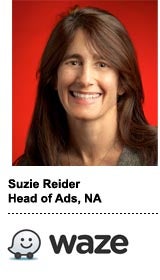Don’t confuse Google’s Waze with its homegrown Maps product.
Waze, which Google acquired in 2013, has a much different value prop.
“Waze is for drivers,” said Suzie Reider, Waze’s head of ads in North America. “Google Maps is about navigating the physical world.”
Waze also has a big community that works collectively to update the maps. That’s how Waze knows that back road that makes such a convenient shortcut is closed for the week: Somebody drove there, checked it out and edited the map.
And that leads to some unique advertising opportunities, which Reider is tasked with developing. Reider, who came on board in December after long stints at Google and YouTube, hopes to strike deep relationships with restaurants, fuel stations and retailers and use Waze’s data and advertising opportunities to drive business results.
She spoke with AdExchanger about her plans for the coming year.
AdExchanger: How will your YouTube skill set transfer to Waze?
SUZIE REIDER: There’s the operations leadership management piece, and there’s the industry piece of it. Then there’s what you build for the ad products.
On the leadership side, it’s recognizing how you work with product teams in an environment that’s community oriented. Waze maps editors create the maps and community. That’s what’s vibrant about Waze, just like YouTube.
You have to maintain your respect for the community that has created the platform.
So how does advertising factor into this? What ad products do you currently have?
There’s the zero-speed takeover. When you’re stopped, there’s a takeover ad unit that comes up. You can talk to it, save it for later or navigate to the place it’s suggesting you go. There are branded pins. There are custom voices, so when Liam Neeson’s movie “The Commuter” came out, we offered his voice.
And those are targeted?
We have pretty sophisticated targeting for those ad units. We know peoples’ work or home address. We know what their commute route looks like, if they get coffee after the gym. We have proxies that can tell if they’re parents, so we can build segments out of those.
We have a segment called Hungry Wazers, which are people that eat more when they’re driving.
To what extent has Google impacted ad development?
Waze is a separate company within Google. We have our own ads engineering team, we have our own product management team.
The Waze team operates under the leadership of Noam Bardin, who is the CEO and was the CEO when Waze wasn’t owned by Google.
Considering your YouTube background, was your hiring an indication that Google wants to bring Waze deeper into its ecosystem?
There was an opportunity to work on something that is relatively small, a super-innovative company with only 350-360 people and still within the construct of Google. I had met Noam a couple of years ago, and I’m a huge Waze user.
It was also the opportunity to work on products for customers – how Waze can help impact the businesses of restaurant, fuel and retail. The things that excited me are about deep partnerships and integrations in key verticals.
We launched a year ago, well before I came on, a Dunkin’ Donuts Order Ahead integration on Waze. That should give you an inkling of what’s to come.
What’s top on your agenda?
Letting key verticals – retail, restaurants, fuel – know that we’re here and we’re focused on their businesses. When I arrived at Waze, the team had done a phenomenal job, but without a lot of focus. Understanding where Waze can be a benefit to these businesses is a big thing.
The product team has been working on integrating DBM [DoubleClick Bid Manager] and Waze. We’re in a pilot phase of that now. That was a big product engineering effort that needed to happen.
We have campaigns that are running. If you’re calling an advertiser and they say we need to run on DBM and you can’t, that can be a blocker.
Does Waze have big plans around its DBM integration?
I wouldn’t say that that’s the big strategy for 2018. In a world of programmatic media, most publishers need to be able to work in a programmatic environment.
How big is your ads team?
It’s about 40-50 people. We have been hiring as we look at the needs in certain regions.
What sort of expertise are you looking for?
Out-of-home is part of our strategy. We’re hiring a team who deeply understands the out-of-home industry and has a lot of strong, professional relationships and can help out-of-home agencies understand how Waze is like a digital billboard.
All of the holding companies have out-of-home agencies, and we’ll have a team calling them.
How do clients think of Waze in terms of their marketing mix?
We are a location marketing vehicle. We’re one of the only marketing vehicles that will give turn-by-turn directions to a drive-through curbside or front door to a retailer.
Do you share data or learnings with Google?
I can’t be specific about what data is shared between Google Maps, Geo and Waze. Where it makes sense to work together, we will.
How are you thinking about GDPR and ePrivacy?
We are a Google company. At this moment, all of the GDPR requirements are being worked through by our product and engineering teams.
Will you need to present a different version of Waze depending on what country the user is in?
I don’t know that yet. I know we’ll be compliant.
What is your measure of success for 2018?
My measure of success will be that companies, in the three focused verticals I’m choosing – QSR, retail and fuel – identify Waze as the key contributor to their business growth.
Can you tell me how much ad spend goes through Waze?
No.
I had to ask.
Interview has been edited and condensed.














